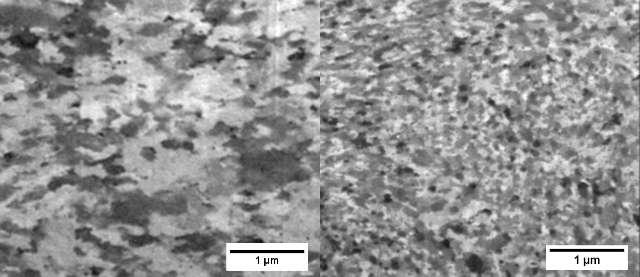Sep 17 2013
Researchers from North Carolina State University have developed a new theoretical model that will speed the development of new nanomaterial alloys that retain their advantageous properties at elevated temperatures.
 The model correctly predicted the material on the left would not be stable at high temperatures and that the material on the right would retain its nanoscale grain size. Click to enlarge. (Image: Mostafa Saber.)
The model correctly predicted the material on the left would not be stable at high temperatures and that the material on the right would retain its nanoscale grain size. Click to enlarge. (Image: Mostafa Saber.)
Nanoscale materials are made up of tiny crystals, or grains, that are less than 100 nanometers in diameter. These materials are of interest to researchers, designers and manufacturers because two materials can have the same chemical composition but very different mechanical properties depending on their grain size. For example, materials with nanoscale grains can be harder and stronger than chemically identical materials with larger grains.
But widespread use of nanoscale materials has long been handicapped by the tendency of nanoscale grains to grow when exposed to elevated temperatures – thereby losing their desired mechanical properties.
This is a problem because creating bulk materials from powdered nanomaterials involves exposure to high temperatures, and even nanomaterials made using other techniques may be exposed to elevated temperatures. The grains in some nanomaterials can even grow – and lose their desired properties – when exposed to room temperature for an extended period of time.
A team of NC State researchers decided to tackle the problem by exploring a concept that had been discussed in the research community for some time: stabilizing nanomaterials by introducing small amounts of an additional element. The idea is that this additional element would serve as a stabilizing agent, migrating to the grain boundaries – or interfaces between grains – and preventing the grains from growing at elevated temperatures. Implementing that concept had been daunting, since there are thousands of possible combinations of these elements.
To turn that idea into a practical solution, the researchers developed a theoretical model to identify suitable candidates that can be used as stabilizing agents.
The theoretical model focuses on alloys that consist of two elements, such as iron and chromium, then allows users to see what would happen if a third element is added to the mix. If users plug the atomic size and thermodynamic properties of each element into the model, the model predicts the grain size of the alloy at any given temperature.
“This model allows anyone to design alloys in a targeted and effective way without having to resort to a trial-and-error approach,” says Dr. Ron Scattergood, a professor of materials science and engineering at NC State and senior author of a paper describing the work. “And our experimental results confirm the accuracy of the model.”
“We are already using the model in our investigations into lightweight aluminum alloys and high-temperature alloys for nuclear energy applications,” says Dr. Mostafa Saber, lead author of the study and a postdoctoral research scholar in materials science and engineering at NC State.